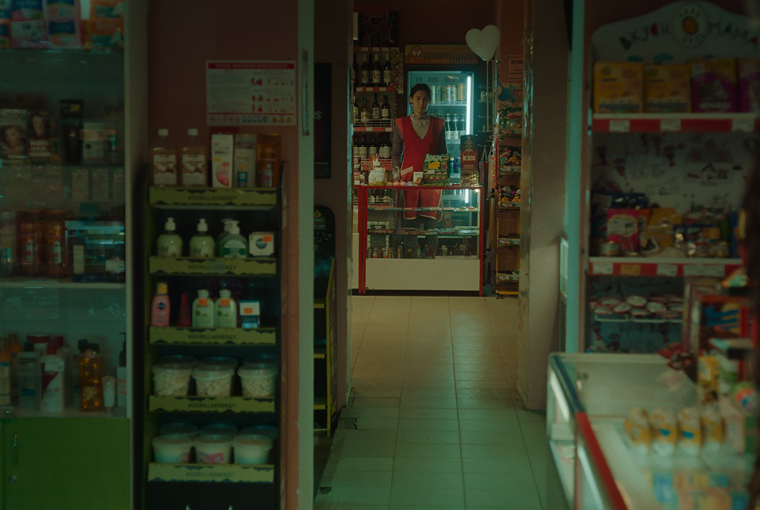Motherhood and Slavery in Contemporary Russia
Michael Borodin’s Convenience Store (Produkty 24, 2022)
Vol. 124 (April 2022) by Antonis Lagarias
While discrimination against Central Asian nationals and structural racism in present-day Russia are well-documented subjects,1 they remain relatively unknown issues in the West. The harsh exploitation of migrants working in contemporary Russia inspired Michael Borodin’s debut feature Convenience Store, which screened in the Panorama section of this year’s Berlinale. Partly based on real-life events, the film focuses on a 24/7 convenience store in Moscow. While the employees of the store are all Uzbek migrants, the customers of the store are almost exclusively white, establishing the underlying social hierarchy from the outset. The dream of a multi-ethnic Soviet utopia once expressed in Vertov’s A Sixth Part of the World painfully contrasts with the film’s depiction of contemporary Russia.
The 24/7 convenience store is a dystopic work environment managed by Zhanna (Lyudmila Vasilyeva), a blond middle-aged Russian woman who confiscated the migrants’ passports upon their arrival and now pays them a meagre salary, as well as physically and verbally mistreating them. The employees are also sexually abused by the local mob, which has close ties to the police force. The first part of the film introduces what can only be described as a modern version of urban slavery. The employees are trapped inside the store, a space visually transformed into an asphyxiating labyrinth through Ekaterina Smolina’s camerawork as the film’s vivid colors shape a vibrant consumerist universe that crassly diverges from the gloomy work conditions. The first part of the film is set inside the store and is a raw yet delicate portrait of oppression. The second part becomes more personal as the film turns its focus exclusively to Mukhabbat (Zukhara Sanzysbay), a pregnant migrant working in the store.
Motherhood strongly overlaps with exploitation at the workplace, and for Mukhabbat the two conditions contribute to what will eventually become an inescapable state of financial and emotional devastation. In the beginning, Mukhabbat patiently takes in the violence around her without intervening, even as she witnesses a case of torture. But after Mukhabbat gives birth, Zhanna takes away the baby, claiming it will have a better life if she raises it in her stead. Seeing her son stolen from her becomes the catalyst for a much-needed act of defiance against oppression. Mukhabbat escapes the store and denounces the whole operation to a group of a human rights activists. However, they prove incapable of helping and her attempt to bring about change eventually fails.
Despite the fact that the film stays close to her point of view, a distance remains between Mukhabbat and the viewers, who never really get to understand her fears, desires and thoughts beyond the obvious family/working framework. In the absence of a personal independent voice, Mukhabbat sometimes feels like solely being a representative of her ethnic community, her on-screen identity limited to that of an exploited worker or a desperate mother. When she eventually escapes this double dynamic, Mukhabbat embarks on a solitary journey back to Uzbekistan, leaving her son behind. Returning to her homeland means abandoning her role of a mother to reclaim that of a daughter and reunite with her own mother, whom she had abandoned several years ago. However, her quest for freedom proves to be short-lived when financial priorities dominate over family dynamics. Finding her mother in a dire financial state, Mukhabbat is obliged to find work in the local cotton field. If Moscow represented a dystopian metropolis filled with indifferent consumers and carried by urban slavery and exploitation, in Uzbekistan slavery takes its well-known rural form for low-wage and female-only agricultural workers.
How to represent the exploited and oppressed is a much-debated topic in cinema, dating back to the origins of class struggle.2 Few films have been able to provide a satisfactory answer that goes beyond either idealizing or victimizing its subjects. However, as exemplified by Convenience Store, films representing the harsh conditions of the working class no longer feel obliged to search for the once-necessary emancipatory narrative. The lack of tangible alternatives and the deep sense of helplessness depicted by the film are both striking. Sometimes, this will make the film verge on the all-too-obvious. For instance, a discussion taking place after the long-expected reunion of Mukhabbat with her mother, where the latter almost immediately mentions the expected increase in the house expenses due to Mukhabbat’s presence, comes off as an overzealous effort by the director to underscore the economic conditions of Mukhabbat’s reality. The film depicts a world where financial needs and extreme work oppression erase all other aspects of life and ultimately lead to different forms of dispossession. Through her exploitative work relation, Mukhabbat is deprived of her income, her child and her motherhood, and the film ends with her losing any hope for a better future too. Her final choice to abandon Uzbekistan a second time and return to Russia, Zhanna and her baby, only confirms that slavery is still alive in different forms, that change will never come, and that compromise is the only option when faced with such dire circumstances.
The film is equally unforgiving in its depiction of activists, who seem tired, inefficient and themselves trapped in a world with no sense of alternatives, neither realistic nor utopian ones. Mukhabbat eventually becomes what her oppressors see her as: a person with limited agency that is easy to exploit. Her last appearance, having changed the color of her hair from black to blond (a color associated with Zhanna) possibly marks the irrevocable end of her defiance and the acceptance of her role between a powerless victim and a conscious collaborator to the slavery operation. Since the exact reasoning behind her choices is never really shared with the audience, it is hard to say if a different, perhaps hopeful ending would have been possible.
Of course, exploiting workers does not necessarily require imprisoning them, nor even the police corruption seen in the film. The recent so-called migration crisis revived forgotten memories of European states implementing legal labor migration in 1960s. The promise of prosperity for migrant workers was never fulfilled, with housing being notoriously inhumane as immigrant labor became the backbone of post-war European reconstruction. Present-day labor migration is based on similar neoliberal promises of “labor heavens”. Each “developed” country exerts its influence on neighboring countries, whose work force it can absorb and exploit. In doing this, employers don’t always have to resort to illegal means. The current minimum wage in most countries hardly allows for a dignified life, and the recent invention of “flexible” employment, like zero-hour contracts or self-employment, allows for the continued exploitation of all workers, migrants, and locals within a legal framework.
While admitting its own impossibility to imagine a solution, Convenience Store’s cruel realism acknowledges the dark side of labor migration. Bringing to light the exploitation of Central Asian nationals, the film eventually acts as a warning against the false promises of labor heavens in advanced societies. In a surreal turn, the last scene shows the convenience store rising into the air, where it remains suspended and disconnected from its surrounding urban fabric. This final image may have a double meaning. On the one hand, it emphasizes the function of the store as a microcosm that is both inaccessible and inescapable. On the other hand, the store’s newfound place up in the sky means that it is now visible to the public eye. Change, while impossible within the boundaries of the film itself, may emerge from the outside once the problem becomes painfully visible.
References
- 1.See for instance a recent academic study on psychological distress among Central Asian immigrant women in Russia: https://www.sciencedirect.com/science/article/pii/S2666560321000116 [accessed on 14/2/2022].
- 2.For instance, the screening of A Film Like Any Other of Jean Luc Godard in the midst of May `68, led to a heated discussion among the director, representatives of French unions and cinephiles on questions about the ethics and legitimacy of addressing working-class issues in film. For details, see Nouel, Thierry. Débat autour d’Un film comme les autres de Jean-Luc Godard. Sur la conservation des documents de 68, La Revue Documentaires, vol. 22-23, no. 1-2, 2010; pp. 148-159.




Leave a Comment